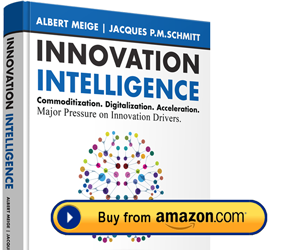This article is the third of a series about commoditization, after Products becoming increasingly complex assemblies of components.

We selected distance measurement in the construction industry to illustrate how products meant to serve a basic customer need are shifting from a mere tool for that basic function to a more complex product or service with a wider range of purposes. The product or service remains centered on the basic need of the customer, but it now encompasses addition, peripheral needs, progressing from the initial basic functionality to a service-oriented package.
One approach to achieving this progression, and therefore improve customer satisfaction, is for the company to focus on reducing the amount of consumer effort required to use the product. There are many types of effort and potential solutions for reducing each:
- Physical effort: solutions include motors in chainsaws and lawn mowers, electric engines in toothbrushes, and power windows in automobiles
- Adjustment effort: solutions include automated focus and anti-shake for cameras, and cruise control for automobiles
- Attention effort: solutions include cooking timers and spellcheck for documents
- Waiting effort: solutions include instant cameras, print-on-demand, and instant pain relief
- Repetitive-action effort: solutions include robotic vacuum cleaners and teaching machines
- Recordkeeping effort: solutions include additional memory, customized parameters, and automatic saving
- Carrying and storage effort: solutions include miniaturization
Another way of improving customer satisfaction is to provide ways for the product to be customized to each customer’s preferences. This approach is particularly important for mass-produced products that run the risk of homogeneity. For a mobile phone, customization can include colorful cases, ringtone options, sophisticated parameter settings in the operating system and in individual apps, insurance against loss or breakage, and countless contract possibilities offered by phone carriers.
When creating a bundle by adding features to a product that is dedicated to performing a basic function, at each step the product designer must focus on customers’ needs, attempting to meet more than the basic need. As a result, the feature bundle, accumulated over the course of many innovation cycles, gradually inhabits a wider space around the customer’s basic objective, solving all possible ancillary problems. The product can then be seen as a full-service package around the product’s main purpose.
This trend of turning a product into a service package is widely applicable. As stated by Jean-Christophe Simon, Director of R&D and Innovation at Groupe SEB, customers want a total solution. Thanks to the large selection of technologies available, delivering a bundle that approaches such a total solution is increasingly possible.
The shift from a product to a service package is also changing customer expectations, which has consequences for business models. Providing a broader and better service to the customer should enable the company to reap a greater reward than it does for less elaborate products. To this end, it is often wise to change the business model and adapt the marketing approach for the new product or service in order to differentiate it from the former one.

The trend pushing industry players to innovate by enlarging the service aspect of their product is related to the permanent fight against commoditization. Development of service-oriented offerings is also occurring in B2B businesses. In the inset below, we recount the example of Air Liquide, a company that provides industrial gases to a variety of industries. Air Liquide has developed service-oriented packages around their basic product, industrial gases, with a different package for each industry. Oerlikon-Balzers, a company that provides hard coating for cutting tools for the mechanical industry, is another example of the transformation from product to service. Today, for large companies such as automotive plants, Oerlikon-Balzers’ coating service has evolved to a full-service package that includes the following services for worn tools: collection, cleaning, removal of former coatings, sharpening, coating with a dedicated hard-vacuum coating, control, packing, and delivery. The service package also includes rapid response, because Oerlikon-Balzers’ coating centers are located near the large mechanical plants.

as always there” service package. Gradually, gas supplier is becoming a highly technical gas supply service. Gas-supply service packages are complex products, combining logistics, labor, control, and servicing, as well as the gas itself. The complexity of the service package is also related to its customization to a customer’s size and industry. The requirements of a semiconductor manufacturer are quite different from those of a polymer plant or a hospital.
***
This article was initially published in the book Innovation Intelligence (2015). It is the second section of the fourth chapter.



